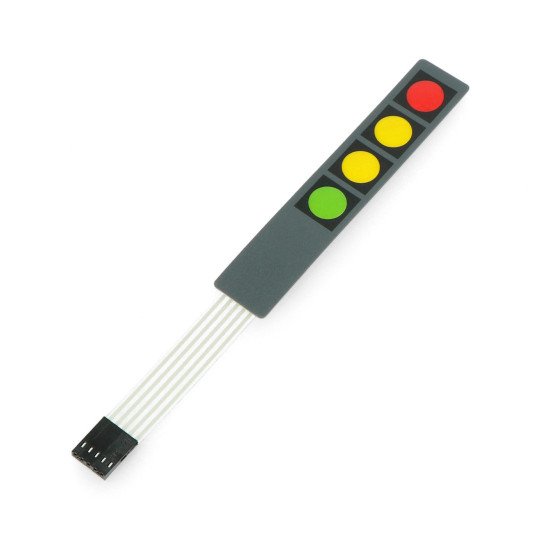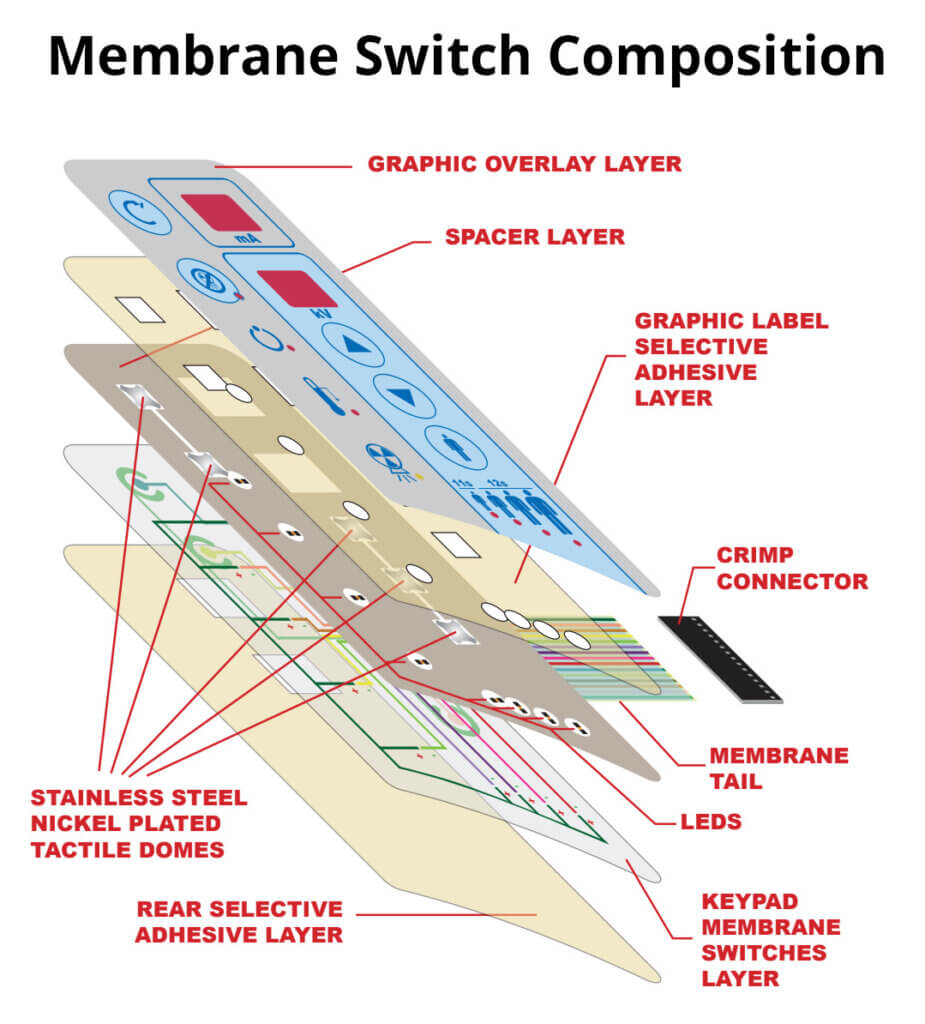Comprehending the Value of Membrane Switch in Modern Electronic Devices and Their Applications
Membrane switches over work as a crucial part in modern electronic devices, using a reliable interface for user interaction. Their customizable and light-weight nature makes them ideal for a variety of applications throughout diverse markets. Recognizing their crucial parts and advantages can supply understandings into their growing importance. As technology remains to breakthrough, the evolution of Membrane switches over raises questions about their future applications and style technologies. What lies ahead in this dynamic area?

What Are Membrane Buttons?
Membrane buttons are essential elements in modern electronic devices, acting as interface that facilitate communication between devices and individuals. These switches include a number of layers, consisting of a graphic overlay, an adhesive layer, and a circuit layer, every one of which work with each other to develop a resilient and functional user interface. The design permits for a flat, low-profile solution that can be tailored relating to size, form, and aesthetic appearance, making them ideal for various applications, from customer electronics to clinical tools. The tactile responses provided by Membrane changes boosts customer experience, while their resistance to dust and wetness makes them ideal for challenging settings. Additionally, Membrane switches can incorporate attributes such as backlighting and printed graphics, further increasing their usability. Their flexibility and robustness make them a preferred option in sectors where integrity and ease of usage are critical, eventually adding to the smooth procedure of modern electronic devices.
Secret Components of Membrane Switches Over
While numerous parts contribute to the performance of a membrane layer button, 3 primary layers play considerable functions in its style and operation. The top layer, generally made from a long lasting polymer, acts as the user interface for individual communication, typically featuring printed symbols and graphics. Underneath this is the spacer layer, which maintains the needed range in between the top layer and the circuit layer. This spacer layer assurances that the button turns on just when pushed, preventing accidental inputs. The circuit layer contains conductive traces that complete the electrical circuit when the top layer is dispirited. These traces can be made from numerous materials, consisting of copper or silver. With each other, these elements produce a trustworthy and durable gadget that is compact and functional, ideal for a large range of electronic applications, from home home appliances to medical tools. Recognizing these essential components is essential for appreciating the general functionality of Membrane buttons.
Advantages of Using Membrane Switches

Membrane Switch Production Process
Recognizing the Membrane button manufacturing procedure exposes the intricate actions associated with producing these important components. The process commonly begins with the design stage, where formats and specs are created making use of specialized software program. Following this, the graphic overlay is published on a flexible substratum, frequently utilizing high-resolution printing techniques to ensure clarity and precision.Next, the sticky layers are used, which serve to bond the different parts together. The circuit layers, made from conductive inks or products, are after that printed onto a separate substratum. These layers are carefully lined up and laminated flooring to create a practical switch.After setting up, the buttons undertake checking to validate functionality and toughness. Quality assurance steps are applied throughout the process to determine and remedy any kind of defects. The completed Membrane buttons are packaged and prepared for circulation, all set to meet the demands of modern electronic applications.
Applications of Membrane Changes in Different Industries
Membrane switches are progressively used throughout different sectors, specifically in clinical tools and customer electronic devices. In the clinical area, they supply trusted control user interfaces for tools that call for specific procedure. In a similar way, in customer electronic devices, these switches enhance user interaction by offering sleek and receptive user interfaces.
Medical Tools Control
Various modern medical tools make use of Membrane buttons for structured procedure and improved individual interaction. These switches supply a reliable, durable user interface for a range of applications, including analysis devices, patient tracking systems, and surgical instruments. Their customizable designs permit details formats that can accommodate the special needs of medical care experts, guaranteeing intuitive navigating and efficient accessibility to crucial features. Furthermore, Membrane switches are immune to impurities, making them ideal for clean and sterile settings. The tactile responses they provide can improve individual confidence, lowering the risk of mistakes throughout crucial clinical treatments. In general, the assimilation of Membrane switches in clinical tools substantially adds to boosted operational effectiveness and individual safety in health care setups.
Consumer Electronic Devices Interfaces
In the domain of consumer electronics, Membrane buttons play a crucial function in enhancing customer interfaces across a large range of tools. These buttons are essential to items such as remote controls, microwaves, and video gaming consoles, giving a easy to use and efficient interface. Their style permits a smooth integration of graphics and functionality, allowing manufacturers to produce check here smooth, modern-day aesthetic appeals without endangering use. Membrane buttons are additionally known for their toughness, frequently standing up to extensive use and exposure to different environmental conditions. Furthermore, they can include functions like backlighting and responsive comments, additional enhancing the individual experience. As consumer demands for advanced yet intuitive interfaces grow, Membrane changes remain to be a necessary element ahead of time electronic device functionality.
Design Factors To Consider for Membrane Switches Over
Creating efficient Membrane switches calls for mindful interest to various variables that influence both capability and customer experience. One crucial factor to consider is the option of materials, as they can impact sturdiness, tactile comments, and visual additional resources charm. Choosing a suitable adhesive is essential for assuring lasting bond and resistance to ecological factors.In enhancement, the format and style of the switch have to suit individual interaction, with switch dimensions and spacing enhanced for convenience of use. The incorporation of graphics and labeling need to prioritize quality and exposure under various lights conditions.Consideration of electrical features, such as actuation force and button level of sensitivity, will enhance the responsiveness of the Membrane switch. The layout ought to suit manufacturing processes to assure cost-effectiveness and timely manufacturing. In general, a well-balanced design boosts both the performance and the customer experience of Membrane switches in contemporary electronic devices.

Future Fads in Membrane Switch Modern Technology
As technology continues to advance, Membrane switches are positioned to incorporate new developments that will certainly boost their capability and application in various areas. One significant pattern is the consolidation of adaptable and durable products, which will certainly enhance the lifespan and integrity of these switches. Boosted surface area appearances and adjustable graphics are additionally anticipated, permitting for more user-friendly user interfaces.Moreover, the assimilation of smart modern technology, such as touch-sensitive surface areas and haptic responses, is anticipated to boost user interaction, making Membrane switches extra responsive and appealing. Additionally, advancements in printed electronics will allow much more intricate circuitry within thinner accounts, better increasing design possibilities.Sustainability will certainly likewise play an essential role in future growths, as makers check out environment-friendly materials and production procedures. On the whole, these fads will certainly ensure that Membrane changes remain crucial and appropriate in a progressively digital and interconnected world.
Regularly Asked Concerns
How Do Membrane Switches Contrast to Conventional Mechanical Switches?
Membrane switches over deal benefits over traditional mechanical switches, including lowered size, lighter weight, and boosted toughness. They normally offer a secured surface area, enhancing resistance to dirt and dampness, making them ideal for varied applications.
What Materials Are Commonly Utilized in Membrane Switch Building And Construction?

Can Membrane Switches Over Withstand Extreme Environmental Issues?
Membrane buttons can hold up against severe ecological conditions, relying on their style and materials. Top quality constructions often include toughness against temperature level variations, humidity, and direct exposure to chemicals, making them ideal for different demanding applications across markets.
For How Long Do Membrane Changes Generally Last Prior To Failure?
Membrane changes typically display a lifespan varying from 1 to 10 million actuations, depending upon factors such as usage frequency, ecological problems, and manufacturing top quality. Normal maintenance can prolong their longevity and functional dependability substantially.
Are Membrane Switches Over Adjustable for Details Applications?
Membrane switches are without a doubt adjustable for details applications. They can be customized in size, performance, and style, enabling makers to fulfill unique user requirements and enhance product aesthetic appeals while preserving functional efficiency and longevity. Membrane buttons are crucial components in contemporary electronic devices, offering as individual interfaces that assist in interaction between users and devices. The responsive comments offered by Membrane changes improves user experience, while their resistance to dust and dampness makes them excellent for testing atmospheres. The incorporation of graphics and labeling should focus on quality and exposure under numerous illumination conditions.Consideration of electrical characteristics, such as actuation force and button sensitivity, will boost the responsiveness of the Membrane switch. Boosted surface textures and adjustable graphics are likewise anticipated, permitting for more intuitive customer interfaces.Moreover, the combination of smart modern technology, such as touch-sensitive surfaces and haptic feedback, is anticipated to improve customer communication, making Membrane switches over much more engaging and receptive. Membrane switches over offer benefits over conventional mechanical buttons, including minimized size, lighter weight, and improved longevity.